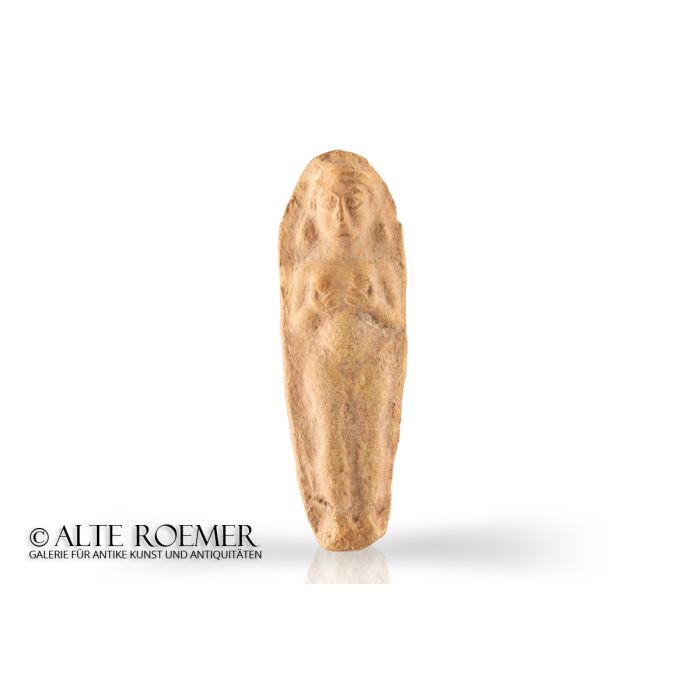Clay figurine of the goddess Astarte
Price: on request
Sold
Object number
AR3443
| Object: |
Clay figurine of the goddess Astarte
|
| Material: |
Clay.
|
| Period: |
Around 600 BC. Neo-Babylonian period. |
| Description: |
Mold made figurine from Mesopotamia or the eastern Mediterranean. It shows the goddess Astarte or Inanna naked and standing upright. The rear surface appears like a wall. The arms of the female figure are bent, her hands grasping the breasts. The long hair is held back with a headband or diadem. The facial features with almond-shaped eyes are in relief. The back is convex and smoothed. Remnants of a dark red colouration can be seen there. Remnants of dark colour can also be seen on the face, which probably once emphasized the facial features. The figure thus returned the viewer's gaze with wide-open, rimmed eyes.
|
| Background: |
The Semitic goddess Astarte was worshipped in the eastern Mediterranean, and in a similar form in Mesopotamia, under the name Inanna or Ishtar. She stood for love, sexuality, war and healing, among other things. The figure presented here can also be seen as a continuation of the even older tradition of the so-called fertility idols, as Garwer explains in the book referenced below. The older idols are archaeologically documented in large numbers and in many varieties. The hand position in front of or under the breast is typical. Finds often come from votive offerings in which a female figure was placed together with animal figures and chariot models. The idols were also found under floors. This evokes associations with household gods that are handed down from the Old Testament as teraphim (e.g. Gen 31:19 ELB, 1 Sam 19:13 ELB and Hos 3:4 ELB). |
| Dimensions: |
9.8cm high. 3.1cm wide.
|
| Condition: |
Perfect condition. Only minor and probably ancient nicks. Remnants of a dark red engobe on the back. The relief on the front is barely worn, but the molded front bears visible signs of wear of the mold, with the product still being quite sharp overall. The figure can't stand on its own and lies on its back without additional support.
|
| Provenance: |
Acquired by us in 2023 from T. Schloessner, Germany. Previously in the German Steinbock family collection, built between 1920 and 1982 by the art historian R. Steinbock, mostly acquired on the German art market.
|
| References: |
Cf. C. Garwer, Sammlung Köhler-Osbahr, volume 1, p. 12, cat. no. 16. Cf. British Museum, acc. no. 1856,1223.460. |
| Literature: |
A very good and compact overview of the idols of the Mediterranean is given by G. Zahlhaas, Idole - Frühe Götterbilder und Offerings (exhibition catalogue of the prehistoric state collection of Bavaria Germany, volume 12, 1985).
|
| Authenticity: |
We unconditionally guarantee the authenticity of every artefact, all items are subject to our lifetime return policy on authenticity.
|


